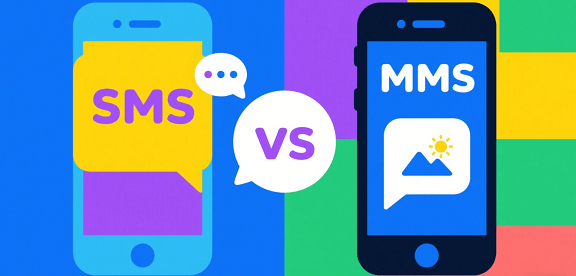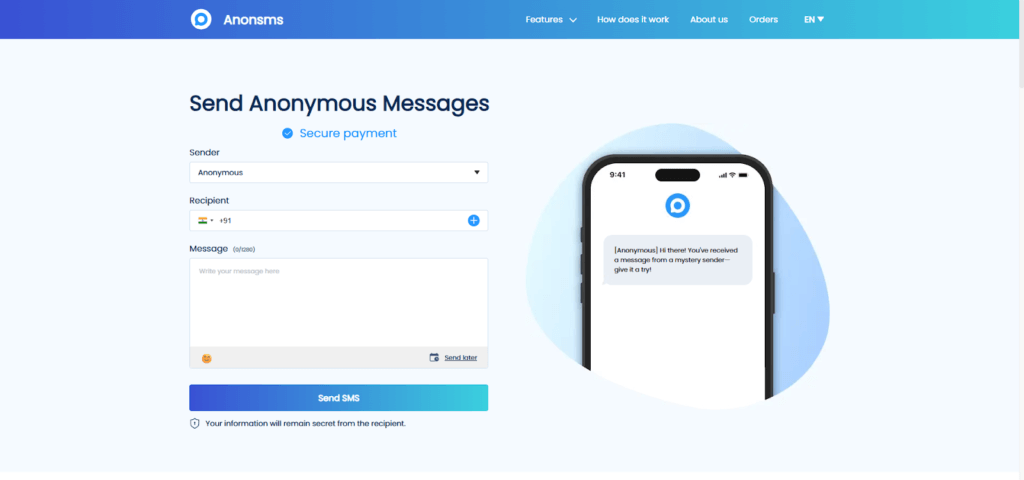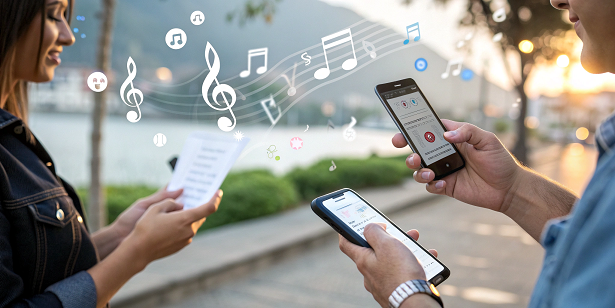¿Sabías que más de 90% de mensajes de texto se leen en menos de tres minutos? La mensajería móvil se ha convertido en una parte esencial de la vida diaria y se envía miles de millones de veces al día en todo el mundo.
Usamos la mensajería móvil a diario para reservar, verificar cuentas y compartir eventos especiales. Dos de las formas más comunes de compartir información con el teléfono son los SMS y los MMS.
Entonces, ¿qué es MMS y SMS? ¿En qué circunstancias deberías elegir uno u otro? Compararemos estos dos métodos de mensajería populares en detalle, analizando sus significados, características, diferencias, costos y aplicaciones, para que tengas toda la información necesaria para elegir la forma más efectiva de enviar mensajes.
¿Qué es SMS (Servicio de Mensajes Cortos)?
Los SMS permiten a los usuarios intercambiar mensajes de texto cortos y sin formato a través de una red de torres de telefonía móvil. En la década de 1980, el desarrollo del GSM permitió que los teléfonos se comunicaran entre sí mediante mensajes cortos de solo texto.
Los mensajes se transmiten a través de canales de control dedicados, lo que garantiza que lleguen a sus destinatarios independientemente de la intensidad de la señal. Cualquier tipo de teléfono móvil puede recibir y enviar SMS. Su funcionalidad sencilla, transmisión rápida y aceptación universal lo convierten en la opción ideal para comunicar rápidamente notificaciones importantes o información breve.
Características clave de los SMS
- El texto simple es el único formato para los mensajes SMS estándar.
- Un solo SMS puede contener un máximo de 160 caracteres. Puedes dividir los mensajes en varias partes para su transmisión mediante concatenación.
- Casi todos los teléfonos hoy en día pueden enviar y recibir mensajes SMS.
- Incluso en áreas con recepción débil o nula, los SMS pueden funcionar utilizando los canales de control celulares.
Los SMS permiten enviar mensajes de forma clara y fiable. Para mensajes importantes, los SMS siguen siendo el método más rápido y fiable.
¿Qué es MMS (Servicio de Mensajería Multimedia)?
El MMS ofrece funciones adicionales a los SMS tradicionales. Mediante este servicio, se pueden enviar imágenes, sonido, vídeos o incluso textos largos. Los mensajes MMS se envían mediante conexiones de datos en lugar de los métodos directos de los SMS. Por ello, permite transferir mensajes más grandes con más tipos de archivos adjuntos.
Al igual que los correos electrónicos, los mensajes MMS comienzan con un asunto. Los MMS te permiten compartir archivos multimedia para que puedas promocionar, invitar o enviar buenos deseos a otras personas con métodos creativos.
Características clave de MMS
- MMS permite enviar y recibir distintos archivos multimedia.
- Puede enviar mensajes más largos con MMS y también adjuntar varios tipos de archivos multimedia.
- Puede resaltar sus mensajes utilizando una línea de asunto que los describa.
- Los mensajes se envían a través de una ruta de solo datos, separada de los canales utilizados para administrar llamadas de voz y texto.
MMS permite a las empresas ejecutar campañas de marketing efectivas, contar historias visualmente e interactuar con los clientes mediante el envío de mensajes basados en medios.
Mensajes SMS vs. MMS: Una comparación directa

La tabla compara las principales características de la mensajería de texto y MMS para ayudarte a elegir el formato que mejor se adapte a tus necesidades.
| Característica | SMS | MMS |
| Tipo de contenido | Sólo texto | Multimedia (imágenes, audio, vídeo) |
| Tamaño/longitud del mensaje | Límite de 160 caracteres | Hasta 1 MB+ (dependiendo del operador) |
| Costo | Más abajo, a menudo agrupado | Superior, puede utilizar datos o incurrir en cargos |
| Potencial de compromiso | Básico | Alto, debido al contenido visual |
| Red de entrega | Canales de control celular | Red de datos |
| Compatibilidad | Funciona en todos los teléfonos. | Requiere un dispositivo capaz y datos |
La comunicación móvil actual se basa en la tecnología SMS y MMS. Muchos prefieren usar SMS, ya que es accesible para todos y económico.
Al mismo tiempo, el MMS permite transmitir todo tipo de contenido multimedia y es ideal para enviar mensajes personales. Si bien es más costoso, ya que depende de datos, añade elementos visuales importantes que facilitan la comunicación al enviar mensajes.
La selección que haga debe depender de su situación y de las personas a las que desea influir con sus mensajes. Los SMS y MMS permiten obtener resultados rápidamente o enviar mensajes visualmente impactantes.
Cuándo elegir SMS o MMS
Elegir entre SMS y MMS implica tener en cuenta los objetivos del mensaje, lo que se desea enviar y a quién se lo envía. A veces, uno es mejor que el otro según la situación específica. Aquí analizaremos las situaciones en las que los diferentes tipos de mensajes son más eficaces.
Cuándo usar SMS
Si necesitas enviar un mensaje corto urgente, los SMS son la mejor opción. Muchos los usan para mensajes urgentes porque son económicos y compatibles con la mayoría de los teléfonos. Por ejemplo:
- Cuando quieres informar a alguien sobre una cita urgente o un cambio de planes, un mensaje SMS es lo más efectivo.
- Dado que los SMS son simples y envían mensajes directamente a los teléfonos, muchos servicios los utilizan para 2FA.
- Un SMS es ideal para responder rápidamente preguntas o consultas sencillas de los clientes.
- Las ofertas por tiempo limitado, en las que se incluye un enlace, llegan a muchos clientes a través de SMS porque es rápido y sencillo para ellos hacer clic.
- El envío de actualizaciones relacionadas con la logística y la programación a los empleados se puede realizar de manera más eficiente a través de SMS.
Cuándo usar MMS
Los MMS deberían ser su mejor opción cuando su mensaje necesite impacto visual o multimedia. Si bien su costo es mayor, el retorno en la interacción y la experiencia del cliente justifican la inversión. Use MMS cuando:
- Realizar campañas de marketing que se beneficien de elementos visuales impactantes, como anunciar el lanzamiento de un nuevo producto o promocionar un evento con un folleto o un vídeo.
- Envío cupones o códigos QR, que son más atractivos y fáciles de usar cuando se envían como imágenes.
- Compartir saludos personalizados, como deseos de cumpleaños o vacaciones con imágenes o audio, agrega un toque personal del que carecen los SMS.
- Presentar productos o servicios con imágenes claras es mucho más atractivo que usar texto simple.
- Aumentar la participación del cliente mediante la integración de medios enriquecidos (como contenido animado o imágenes de marca) puede aumentar las tasas de clics y de conversión.
En resumen, elija SMS por su velocidad y simplicidad; opte por MMS cuando lo visual sea importante.
Implicaciones de costos: lo que necesita saber
Conocer las diferencias de costo entre SMS y MMS es fundamental para quienes usan la mensajería de texto con frecuencia. Los SMS pueden cobrarse por mensaje individual o integrarse en los planes mensuales de un servicio móvil. La mayoría de los planes móviles ahora incluyen SMS ilimitados, lo que los convierte en una forma económica de enviar mensajes de texto con frecuencia.
Los MMS suelen ser más caros, ya que permiten enviar contenido multimedia como imágenes, vídeos y sonidos. Con frecuencia, los mensajes MMS se cobran además de los SMS, o en lugar de ellos, debido a las distintas estructuras de precios de los operadores móviles. Por ello, los MMS suelen ser una opción más cara en regiones donde los datos móviles son caros.
Los precios pueden fluctuar considerablemente según el país y el operador. No todos los proveedores incluyen la mensajería MMS en sus paquetes de datos; algunos cobran un suplemento por cada MMS enviado. El envío internacional de SMS y MMS suele tener cargos adicionales y puede variar según las colaboraciones entre los operadores.
El ahorro de costes es fundamental para las empresas en sus estrategias de SMS y MMS. Muchas empresas que ofrecen... servicios de SMS masivos Cobrar precios más bajos por el envío de grandes volúmenes de mensajes de texto, lo que convierte a los SMS en una forma rentable para que las empresas se comuniquen con sus clientes y destinatarios. Si bien los MMS pueden ser muy eficaces, su costo debe considerarse y calcularse para garantizar un retorno de la inversión satisfactorio.
Servicio de SMS anónimos
En ocasiones, surgen circunstancias en las que la privacidad prima sobre cualquier otra característica de la comunicación. Los servicios de SMS anónimos ofrecen la solución en tales circunstancias. AnonSMS es una opción confiable para enviar un mensaje de texto anónimo por cualquier motivo.

AnonSMS te permite enviar textos internacionales De forma segura y anónima, sin necesidad de registrarse ni compartir datos personales. Usar AnonSMS es sencillo: redacta tu mensaje, proporciona el número del destinatario y envíalo sin demora. Puedes usarlo en todo el mundo, obtener informes de entrega precisos y tener la seguridad de que tus mensajes permanecerán anónimos y sin publicidad.
Desde bromas divertidas hasta alertas confidenciales, AnonSMS es ideal para quienes buscan una comunicación segura y privada. Es una herramienta moderna para la mensajería discreta en un mundo donde la privacidad digital se valora cada vez más. Visita SMS anónimos para explorar sus características y enviar tus mensajes anónimos hoy.
Conclusión
Elegir entre MMS y SMS se reduce a tus objetivos de mensajería. Los SMS son perfectos para una comunicación rápida, rentable y universal. Los MMS son la solución cuando tu mensaje necesita más espacio e impacto visual.
Ambos formatos de mensajería tienen sus ventajas. Si buscas una forma segura, anónima y flexible de llegar a tu público, ya sea para alertas, marketing o uso personal, servicios como Anonsms.com pueden mejorar tu estrategia de comunicación móvil.

 Anonsms
Anonsms
 Caballero
Caballero




